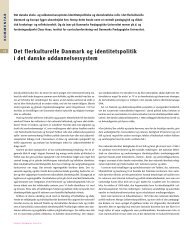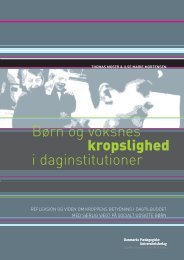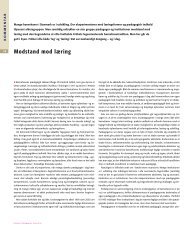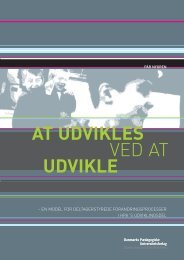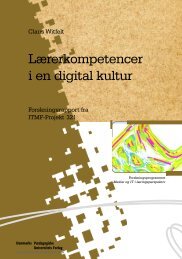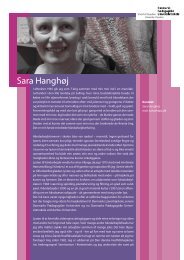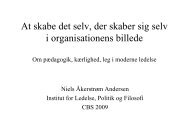SRI-Teknisk rapport-sen.v13 - DPU
SRI-Teknisk rapport-sen.v13 - DPU
SRI-Teknisk rapport-sen.v13 - DPU
You also want an ePaper? Increase the reach of your titles
YUMPU automatically turns print PDFs into web optimized ePapers that Google loves.
K.1 Which variables or concepts, if any, does the<br />
study aim to measure or examine?<br />
K.2 Please describe the main types of data collected<br />
and specify if they were used to (a) to define<br />
the sample; (b) to measure aspects of the<br />
sample as findings of the study?<br />
Explicitly stated (please specify)<br />
classroom instruction and assessment practices,<br />
student learning and motivation, students' and<br />
teachers' beliefs about and attitudes toward the<br />
assessment, and a school characteristic.<br />
Details<br />
The main types of data are collected through questionnaires<br />
to teachers and students. And also<br />
through teachers' sample of instruction and assessment<br />
tasks that were repre<strong>sen</strong>tative of their classroom<br />
materials across the school year. The data<br />
collected were used to measure aspects of the<br />
sample as findings of the study.<br />
K.3 Which methods were used to collect the data? Self-completion questionnaire<br />
K.4 Details of data collection intruments or tool(s). Explicitly stated (please specify)<br />
The questionnaires consisted of both Likert-type<br />
(usually 4-point scales) and<br />
constructed response items. Some questions pertaining<br />
to the support for the<br />
MSPAP and the beliefs about the MSPAP were based<br />
on a previous study in<br />
which the consequences of state assessments were<br />
examined (Koretz, Mitchell,<br />
Barron, & Keith, 1996).<br />
Sets of items on the teacher questionnaire were<br />
combined and validated by using<br />
confirmatory factor analytic (CFA) methods and<br />
measures of internal consistency<br />
to reflect the dimensions described in the following<br />
list (e.g., Lane, Stone,<br />
Parke, Han<strong>sen</strong>, & Cerrillo, 2000). For the purposes<br />
of the CFA, subsets of items<br />
were combined to form two indicators for each<br />
dimension (about equal numbers<br />
of items) except the MSPAP Impact dimension. For<br />
this dimension, only one indicator<br />
was used because the items could not be divided<br />
into two meaningful components.<br />
The indicators within each dimension are also given<br />
in the following list,<br />
as is the total number of items for each dimension,<br />
which varied to a small degree<br />
across content areas:<br />
• MSPAP Familiarity (~6 items): (a) teachers’ general<br />
familiarity with the<br />
MSPAP (i.e., purpose, format); (b) teachers’ familiarity<br />
with MSPAP results<br />
(i.e., ability to interpret, use, and explain results)<br />
• MSPAP Support (~7 items): (a) teachers’ general<br />
support for the MSPAP<br />
111



